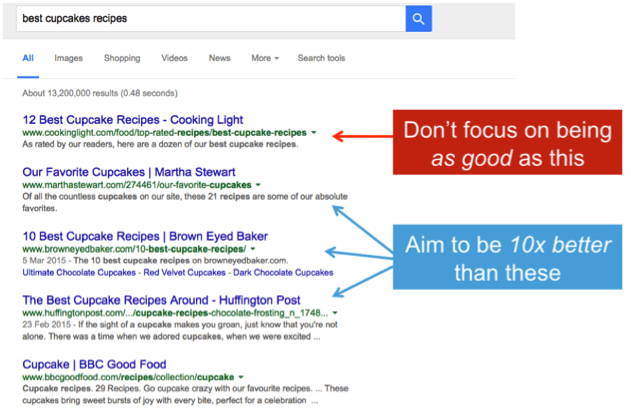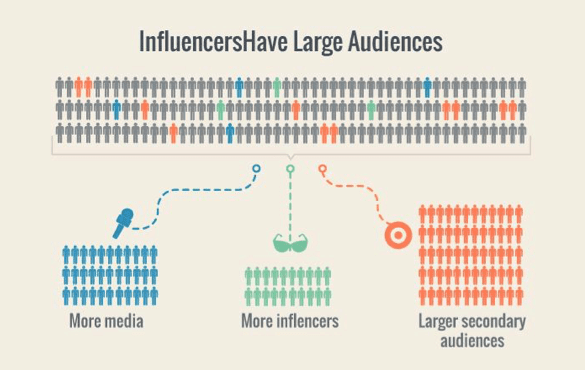Case studies and best practices for producing truly outstanding content
With the ongoing rise in content marketing, smarter search engines and increased competition within the earned media space, what does it take to really stand out and gain attention?
As we start the New Year, now is as good a time as any to aim for a new set of higher standards for the content we’ll be producing in 2016 and onwards.
Recently, Rand Fishkin produced an excellent Whiteboard Friday explaining why the creation of ‘reasonably good, unique content’ must die:
Rand’s main point was that the days of producing reasonably good, useful, unique content is no longer an acceptable level of quality for those aiming to compete by ranking highly and generate interest in search. Instead, we must set our sights much higher:

Source: Moz
The problem with ‘good, unique content’ is that it’s relatively straightforward to produce and can be easily scaled, meaning it’s difficult to obtain a genuine competitive advantage. To have any chance of success, at the very least, content should be as good as the best result in the SERPs. However, to really stand out, content producers should aim to create content ten times better than anything else in the search results.

Gaining a competitive advantage through 10x content
Inbound.org defines 10x content as:
“Content that has gravitas, is enduring and worth paying attention to”
The term ‘10x content’ is just another way of articulating the need for content producers to go above and beyond. The modern criteria for content has changed as a result of the emergence of content marketing as a discipline, the increased focus on user experience, the transition from link building to link earning and ultimately a shift in user expectations. People simply expect more from content today (faster page load, great design, quick answers to questions).
Content creators therefore need to respond. The criteria for 10x content includes:
Entertaining/ moving/ thought provoking
If a piece of content is genuinely entertaining, moving or thought-provoking, it is more likely to evoke an emotional response and generate interest.
Provides genuine utility
Providing utility adds real value. Content should solve a problem for the user, answer a question or help them achieve a goal.
Educational
Similarly to the above, content that fulfils customer needs by educating and teaching them something new or interesting is more likely to build a trusted and emotional connection.
Absorbing/ immersive
An immersive experience is a web environment that uses compelling imagery or video as the focal point of the content to absorb the user’s attention from the moment they hit the site.
Visually stunning
Great visuals and design can be used to augment and add value to other content formats, such as articles, apps and videos.
Detailed
Detailed, long-form content that provides value for the reader has been shown to have higher success rates within search and social and is something that has again been picked up as a possible ranking factor following the release of Google’s quality guidlines.
Includes in-depth research
Content that is well-researched and/ or backed up by sound data and reasoning adds credibility and provides a point of differentiation.
Provides a uniquely positive user experience
Providing a positive user experience should be the minimum standard. 10x content is about providing a uniquely positive user experience that integrates design, branding and UX principles to stand out and offer something different.
Designed and produced for the right web experience (mobile, desktop, tablet, browser)
Content should always be optimised correctly for the target user’s preferred channels and platforms. And with users expecting quick results page load speed is essential, too.
Includes optimised data visualisation/ infographics
Infographics and data visualisations should offer a clear purpose, message and value, backed up by good data and design.
Not all of the above criteria needs to be met in order to be 10x content but it helps when there’s a combination, for example entertaining + visually stunning or data visualisation/ infographic + genuine utility (there are many infographics that look pretty but offer very little value!).
Examples of 10x content
Inbound.org provides a superb list of curated examples of 10x content to ecourage great work. This list inspired me to seek out some 10x content examples of my own which I’ve highlighted here along with some thoughts on what I believe makes the content so good:
Chasing the Chariot: In search of the soul of English rugby

An example from the Guardian of a very well-researched, in-depth piece of content that uses imagery, video and sound recordings to provide a genuinely absorbing reading experience.
McDonald's Killed Burger King's McWhopper, so We Made it Ourselves

When the McWhopper was proposed in summer 2015, there was a lot of coverage both from the mainstream press and across social media. Nevertheless, Serious Eats still managed to rank highly in search by offering their own unique approach to the creation of the McWhopper with content that combined entertainment with education and provided genuine utility for the reader.
How To Suck At Social Media: An Indispensable Guide For Businesses

At over 9,000 words, Avinash Kaushik has produced a social media user guide for businesses that is not only very detailed and well-researched but also educates, provides great utility and includes a number of very useful graphics to bring the frameworks, case studies and examples to life.
Steps to creating 10x content
So how does one go about producing 10x content? For a start, it isn’t easy (which is why there’s a competitive advantage to be had). However, producing 10x content starts with a shift in mind-set and a focus on what can genuinely provide value. And then it’s about putting a process in place that includes the following elements:
Focus on user experience
Content should be readable, optimised for multiple devices and be easy to interact with.
Search engines, particularly Google, also appear to be frowning upon sites that induce ‘pogo-sticking’ - where a link in the SERPs is clicked but the user almost immediately returns to the search results. Relevance and good page load speed are therefore essential to ensuring users find what they’re looking for.
A.B.R. - Always Be Researching
Good content starts with a true understanding of what your target audience will respond to. What are users already searching for? What is generating buzz within the social space?
There are a number of really useful competitor benchmarking tools for content marketing tools such as Socialcrawlytics.com, Quick Sprout and BuzzSumo, all of which can help to identify the type of content activity, strategies and tactics that are working for others and what, as a result, might best work for you.

Solve problems
The goal should be to fulfil the searcher’s task and not just their query.
Most searchers will be looking for a solution to a problem so help them by considering the questions that they’re looking to answer. Some of the research tools suggested above will provide insight but so will other forms of data, including internal site search data, blog comments and search trends from Google and Bing.
Stop producing standard quality content
Standard, ‘1x content’ content is a waste of time. Unless you’re providing real value by being genuinely unique, outstanding or engaging, you’re unlikely to get results.
The days of producing lots and lots of mediocre content optimised around specific keywords are gone. Even large brands with strong domain authority need to create content that goes above and beyond to realise any kind of impact.
Build relationships
Finally, look to build relationships. Share great content by others that’s relevant to your industry, co-operate with other thought-leaders and influencers and engage with customers and prospects across your different social and online platforms.
This type of activity will help foster ties with other content creators, leading to better reputation and visibility.

Source: Moz
Summary
As content creators, we have a responsibility to think carefully about the longevity of the content deluge. With so much content being created, there is a risk of ‘content shock’ and therefore we must raise our standards to stay relevant and add value for consumers.
Not all content can and should be ‘hero’ content. This takes a great deal of time and effort and simply isn’t possible to produce time after time. However, we nevertheless must acknowledge that the criteria for modern content has changed and that more is required to stand out and make an impact.
The goal now is to produce content that is better known, better trusted and better referenced.











